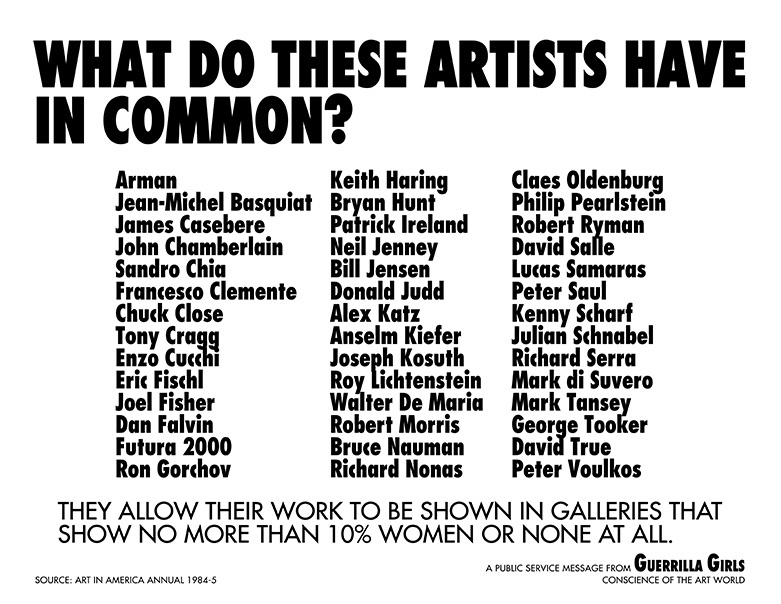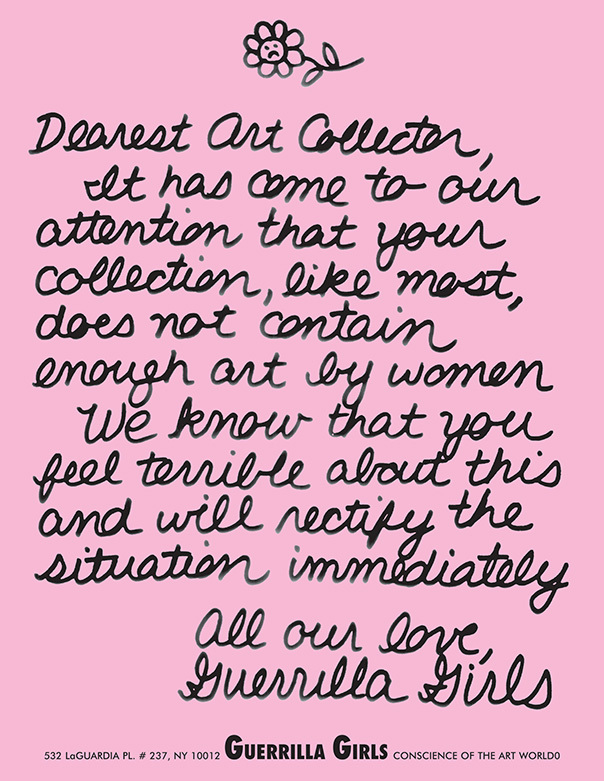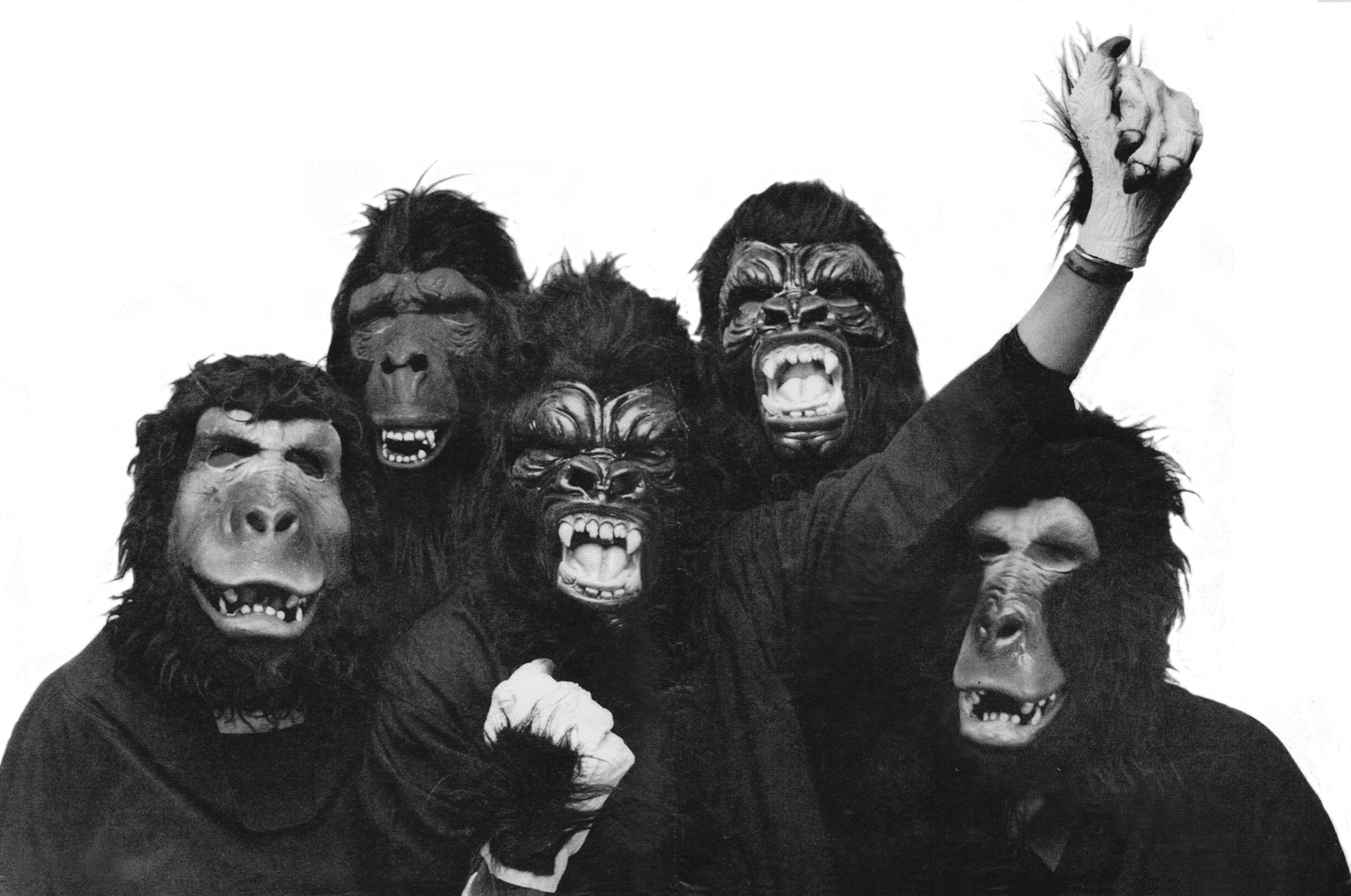There are rumors about who the Guerrilla Girls may or may not be. The artist whose solo show you just saw in Chelsea? Totally. Your art professor? You always hoped so. But speculate away — the masked group of artist ladies is still at large and incognito 30 years after they first announced their mission to right the wrongs of the gender-skewed art world, flyering the lamp posts of Soho with punchy PSAs signed “The Guerrilla Girls: Conscience of the Art World.”

The group formed in 1985, its founding members riled up by the 1984 MoMA show “International Survey of Painting and Sculpture,” a retrospective exhibition which included the work of only 13 women artists, and even fewer artists of color, out of a total of 169. And it’s been hell-bent on disruption ever since. Over the past three decades, Guerrilla Girls have plastered billboards with slogans like “Do women have to be naked to get into the Met. Museum?”; designed and distributed countless posters slamming everything from the male-female pay gap to gender inequality at the Oscars; staged a “weenie count” in the Metropolitan Museum of Art; written five books; and generally given shit to the art world patriarchy. All under the cover of Halloween-shop gorilla masks, and names borrowed from the back catalog of female art.
And while their methodology often relies on lols, their legacy is real. As Gloria Steinem wrote in 1995: “The women’s movement is too diverse for any one symbol…but if I had to name a group that symbolized the best of feminism in this country, I would say, ‘The Guerrilla Girls.’ Smart, radical, funny, creative, uncompromising, and (I assume) diverse under those inspired gorilla masks, they force us to rethink everything from art to zaniness.”
Members have come and gone (the initiation process is obviously highly secretive), but party starters Frida Kahlo and Kathe Kollwitz have been there since day one. They answer our questions below.
How has your mission evolved over the past 30 years?
We began in the art world because we were a group of female artists who saw that things were getting worse for women and artists of color, after some gains due to feminist protest in the 1970s. Almost immediately, we branched out into other areas of culture and politics. We’ve now done over 100 posters, stickers, actions, huge billboards and several books about art, film, pop culture, politics, abortion, homelessness, rape, war and more.

Looking back to 1985, how did you channel your anger over the 1984 MoMA show and create a group that could change things?
We didn’t actually organize that protest in front of MoMA in 1984, but a couple of future Guerrilla Girls joined the picket line and were pissed that it had absolutely no effect. No one going into the museum cared about the lack of women and artists of color inside. That was the aha! moment. We realized there had to be a better way — a more contemporary, creative way — to break through people’s belief that museums knew best and that there was no discrimination in art. We got the idea to do posters, and in spring 1985 we called some friends to a meeting, and passed the hat around to pay for printing. When we put the first two posters up in New York in the middle of the night, all hell broke loose. Who knew that would lead to hundreds of others, plus, books and street projects? Who knew that would cause a crisis of conscience about diversity in the art world, something museums, collectors and critics had denied for a long time. Now, it’s a no brainer…. you can’t tell the story of a culture without all the voices in that culture
What have been some of your most effective campaigns since then?
Our poster “Do Women Have to be Naked to Get Into the Met. Museum?” and some of our film campaigns have been among the most influential. Our goal is to do something unforgettable. After seeing our “Naked” poster, you can never go to a museum without thinking about how many women artists are on the walls.
The Guerrilla Girls have invented a game-changing kind of political art. Humor helps us present issues in unexpected, intrusive ways. We don’t do posters and actions that simply point to something and say “This is bad,” as a lot of political art does. We try to use information in a surprising, transgressive manner to prove our case. We believe that some discrimination is conscious and some is unconscious and that we can embarrass some of the perpetrators into changing their ways. This has proved true in the art world: things are better now than they ever have been for women and artists of color, and we have helped effect that change. (There is still a long way to go, however, and we are still condemning the art world for its lack of ethics, tokenism, economic discrimination and other bad behavior.)

Have you had any run-ins with the law…?
Not really, but our upcoming sticker campaign against billionaires who control the art world today may get us in some real trouble. We do get angry emails from theater owners when we put up anti-film industry stickers in their bathrooms.
Are there other practical difficulties with being a masked avenger?
It’s hot inside the masks! But the good news is you wouldn’t believe what comes out of your mouth when wearing one.
Is wearing masks a protective measure? Do you think Guerrilla Girl members would suffer a backlash in the art world if they weren’t anonymous?
In the beginning, we decided to be anonymous for purely self-serving reasons: the art world was a small place and we were afraid our careers would suffer. But we quickly realized that anonymity was an important ingredient to our success. First, it keeps the focus on the issues, not on our individual work or personalities. Second, the mystery surrounding our identities attracts attention, which is helpful to our cause. We could be anyone…and we are.
A lot of the museums at which you’ve protested, including MoMA, now own work by the Guerrilla Girls. How do you feel about that?
Wary and confused? Happy and excited? It’s true that in recent years we’ve been busier than ever, and we’ve also been faced with a dilemma: What to you do when the art world you’ve spent your whole life attacking suddenly embraces you? We think carefully about every request and if the conditions are right, we take our critique right inside the galleries and institutions. When our work appears at venerable venues like the Venice Biennale, the Tate Modern, or The National Gallery in DC, we get hundreds of letters from people saying they were blown away by our analysis of art and culture. It’s a thrill to criticize a museum right on its own walls.
Credits
Text Alice Newell-Hanson
Photography courtesy the Guerrilla Girls
